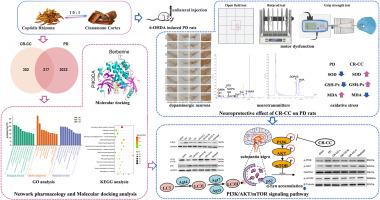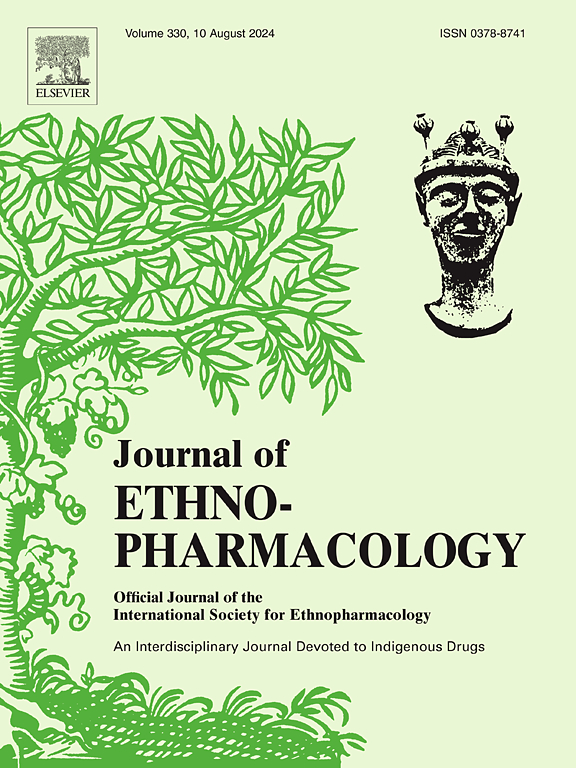Neuroprotective effect of the herbal pair Coptidis Rhizoma-Cinnamomi Cortex against 6-OHDA-induced Parkinson's disease rats through promotion of autophagy via the PI3K/AKT/mTOR pathway
IF 5.4
2区 医学
Q1 CHEMISTRY, MEDICINAL
引用次数: 0
Abstract
Ethnopharmacological relevance
Parkinson's disease (PD) is a common neurodegenerative disorder with a universal and fast-growing increase in both prevalence and incidence worldwide. Coptidis Rhizoma-Cinnamomi Cortex (CR-CC), a classic herbal pair comprising the Jiaotai Pill, has been widely used in clinical practice to improve PD and its associated symptoms including anxiety and insomnia. However, the mechanism of the action of CR-CC in improving PD remains to be fully elucidated.
Aim of the study
To investigate the therapeutic effect of CR-CC against PD rats and the relevant mechanism.
Materials and methods
A rat model of PD was established through unilateral injection of 6-hydroxydopamine (6-OHDA) into the striatum. The therapeutic effects were evaluated by three kinds of behavioral tests, the levels of oxidative stress markers, and tyrosine hydroxylase (TH). The neurotransmitters and their metabolites were determined by UPLC-MS/MS. Immunohistochemistry, immunofluorescence, and western blotting were conducted to detect the TH expression and α-Synuclein (α-Syn) level in the substantia nigra (SN). The potential targets and related signaling pathways were analyzed and predicted using network pharmacology analysis and molecular docking, and the expression of LC3II/LC3I, p62, and the proteins related to PI3K/AKT/mTOR pathways in the SN of PD rats was assessed by western blotting.
Results
CR-CC ameliorated motor dysfunction and oxidative damage in the serum of PD rats and modulated the neurotransmitter levels of the striatum on the injured side. It also attenuated the dopaminergic neuronal loss and abnormal aggregation of α-Syn in the SN, showing similar effects compared with CR and CC administration alone. Network pharmacology and molecular docking analysis suggested that MTOR, PIK3CA, and MAPK3 related to autophagy would be the core targets for the active compounds of CR-CC. Further studies showed that CR-CC increased the LC3II/LC3I ratio, decreased the p62 level, and regulated the expression of proteins related to the PI3K/AKT/mTOR pathway in PD rats.
Conclusion
The results showed that CR-CC exerted neuroprotective effects by regulating autophagy through the PI3K/AKT/mTOR pathway to reduce the α-Syn level in the SN of PD rats and showed similar effects to those of CR and CC alone.

中药对黄连-肉桂皮质通过PI3K/AKT/mTOR通路促进自噬对6- ohda诱导的帕金森病大鼠的神经保护作用
民族药理学相关性:帕金森病(PD)是一种常见的神经退行性疾病,在世界范围内的患病率和发病率都在快速增长。黄连肉桂皮质(Coptidis Rhizoma-Cinnamomi Cortex, CR-CC)是由交台丸组成的经典中药对,已广泛用于临床治疗PD及其相关症状,包括焦虑和失眠。然而,CR-CC改善PD的作用机制尚不完全清楚。目的:探讨CR-CC对PD大鼠的治疗作用及其机制。材料与方法:采用纹状体单侧注射6-羟多巴胺(6-OHDA)建立大鼠帕金森病模型。通过三种行为测试、氧化应激标志物水平、酪氨酸羟化酶(TH)水平评价治疗效果。神经递质及其代谢物采用UPLC-MS/MS测定。采用免疫组织化学、免疫荧光、免疫印迹法检测黑质(SN)中TH的表达及α-突触核蛋白(α-Syn)的水平。采用网络药理学分析和分子对接分析预测潜在靶点及相关信号通路,采用western blotting检测PD大鼠SN中LC3II/LC3I、p62及PI3K/AKT/mTOR通路相关蛋白的表达。结果:CR-CC可改善PD大鼠血清运动功能障碍和氧化损伤,调节损伤侧纹状体神经递质水平。它还能减轻大鼠多巴胺能神经元的丢失和α-Syn的异常聚集,效果与单独给药CR和CC相似。网络药理学和分子对接分析提示,与自噬相关的MTOR、PIK3CA和MAPK3可能是CR-CC活性化合物的核心靶点。进一步研究表明,CR-CC可提高PD大鼠LC3II/LC3I比值,降低p62水平,调节PI3K/AKT/mTOR通路相关蛋白的表达。结论:CR-CC通过PI3K/AKT/mTOR通路调节自噬,降低PD大鼠SN中α-Syn水平,发挥神经保护作用,其作用与黄连、肉桂皮单用相似。
本文章由计算机程序翻译,如有差异,请以英文原文为准。
求助全文
约1分钟内获得全文
求助全文
来源期刊

Journal of ethnopharmacology
医学-全科医学与补充医学
CiteScore
10.30
自引率
5.60%
发文量
967
审稿时长
77 days
期刊介绍:
The Journal of Ethnopharmacology is dedicated to the exchange of information and understandings about people''s use of plants, fungi, animals, microorganisms and minerals and their biological and pharmacological effects based on the principles established through international conventions. Early people confronted with illness and disease, discovered a wealth of useful therapeutic agents in the plant and animal kingdoms. The empirical knowledge of these medicinal substances and their toxic potential was passed on by oral tradition and sometimes recorded in herbals and other texts on materia medica. Many valuable drugs of today (e.g., atropine, ephedrine, tubocurarine, digoxin, reserpine) came into use through the study of indigenous remedies. Chemists continue to use plant-derived drugs (e.g., morphine, taxol, physostigmine, quinidine, emetine) as prototypes in their attempts to develop more effective and less toxic medicinals.
 求助内容:
求助内容: 应助结果提醒方式:
应助结果提醒方式:


